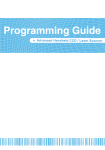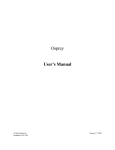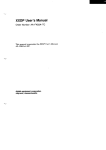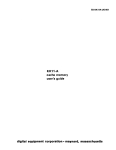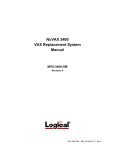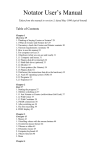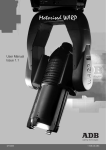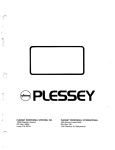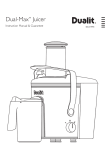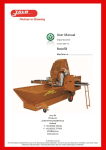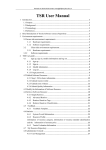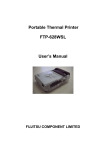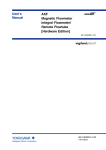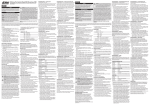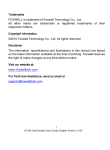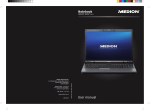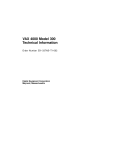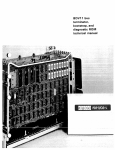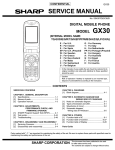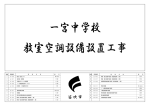Download Notes for XXDP+ and XXDP V2 Operating Systems
Transcript
XXDP Notes for XXDP+ and XXDP V2 Operating Systems Pete Turnbull, February 1993 XXDP - Diagnostic Program Monitor XXDP is a small, compact operating system designed to provide a suitable environment across the range of DIGITAL Q-bus and Unibus machines to run diagnostic (test and maintenance) software. The name comes from the four-character names given to diagnostic programs. XXDP is not intended to provide a software-development environment, this is usually done under, for example, RSX11. Early versions were quite simple and consisted of a monitor program such as RKDP.SAV (the monitor for RK05-based systems) and a few utilities. Later versions, called XXDP+, added a few more operations and used monitors with names of the form HMddvp.SYS (HM signifies a monitor, dd is the device mnemonic, and v and p are the version and patch levels). XXDP+ could tell what kind of bus system it was running on, unless it was an 11/23 or 11/24. XXDP+ Version 1.1, sometimes called XXDP++ or XXDP Super-plus, was basically similar but with some enhancements, notably the introduction of Diagnostic Runtime Services which provided a common supervisor and setup functions for compatible diagnostics. XXDP Version 2 added memory management, English-type commands in addition to the single-letter monitor commands, and device drivers separate from the monitor program itself. Naming Conventions: XXDP.??? where XX is a device mnemonic, and DP stands for Diagnostic Program, is used on oldest versions for monitor and bootstrap programs (eg RKDP.SAV), and for directory listings (eg RLDP.DIR). It is also used for distribution media (eg RKDP is XXDP on an RK05 disk pack). Hxmnrp.SYS used for XXDP+ system files. H means a system file; x may be M,D,U,S,Q representing Monitor, Device Driver, Utility, Supervisor, or miscellaneous files; mn is the device mnemonic for the medium supported; rp specifies the revision and patch levels. Thus HMRLA1.SYS is the system monitor for an RL01/RL02 system, first issue, patch level 1. Special mnemonics include DI (directory utility), SU (setup utility), AA (XXDP supervisor file), AB (PT/AMS supervisor file), SA (user manual). tmnirp.BI? used for XXDP+ (and later) diagnostics, also some .OBJ files. t processor type code, eg V mn device mnemonic, eg RQ i a unique program identifier, eg C rp revision and patch level, eg B2 Thus ZRQCH0.BIC is for any processor, using an RQDX controller, the third diagnostic of a set (this one is a disk formatter), eighth version, never patched or updated. Dtirp.BIN used for Unibus tests; t=type of test, otherwise as above 0 instruction test 1 addressing test 6 AA11/VT06/LAB11 test 8 Unibus test Standard Files: COPY.BIN DATE.SYS DRSSM.SYS XXDP+ copy program XXDP Ver.2 date utility XXDP Ver.2 Diagnostic Runtime Services supervisor for use under the small monitor DRSXM.SYS XXDP Ver.2 DRS supervisor for use under the extended monitor DIR.SYS XXDP Ver.2 directory utility DUSZ.SYS XXDP Ver.2 ???? DXCL.BIN DEC/X11 (automated testing) configurator and linker HELP.TXT Help Text file MN.SYS XXDP Ver.2 device driver for device MN, eg DL.SYS for RL01/2 PATCH.BI? program to patch diagnostics SETUP.BI? Setup utility for DRS-compatible diagnostics UPDn XXDP+ Update utility, n is version 1 or 2 (1 is obsolete, smaller and less useful) UPDAT.BIC XXDP Ver.2 Update utility XTECO.BI? simple text editor XXBLD.BI? utility to build new media containing XXDP system XXDPSM.SYS XXDP Ver.2 small monitor (runs in 28KW or less) XXDPXM.SYS XXDP Ver.2 extended monitor, has 22-bit memory management and can use up to 124KW memory nDIREC.TRY directory listing file, n=1..2..3... Standard File Types: .BAK .BIC .BIN .CCC .DIR .LIB .MPG .OBJ .SAV .SYS .TRY .TXT backup file created by XTECO chainable binary image file binary image file chain file (a batch file containing textual commands) directory listing file, as created by DIR utility library file ??? DEC/X11 object code memory image file (usually executable code) system file directory text file ASCII text file Characters and Wildcards: As XXDP stores filenames in RADIX-50 format, the only legal characters in filenames and extensions are upper-case letters A...Z, and numerals 0...9. The dollar symbol "$" and fullstop or period "." have special significance and should not be used, except that a full-stop is used to separate a filname from its extension. Spaces are not allowed. In most situations, XXDP supports the use of wildcard characters in filenames. ? * represents a single character represents any number of characters Processor Types: A B C D E F G H J K M N P Q R T V X Z 11/05, 11/15, 11/20 11/40 11/45 GT40, general Unibus 11/70 11/34 11/04 used for system files 11/23, 11/24 11/44 MNC-11 System Industrie 9400 controller diagnostics PDT-11, Plessey diagnostics 11/60 LPA-11 .MPG files 11/03 DEC/X11 OBJ files any processor Device Mnemonics used in Diagnostics: AA AD AF AR AX BB BM BT CB CD CL CM CP CT CR DC DF DH DJ DL DM DN DP DQ DR AA11, AAV11 AD11, ADV11, AD01 AFC11 AR11 AXV11 KIT11 BM873, BDV11 Bus Tester CB11 CD11, CDS11 CL11 CM11 DEC/X11 CPU CT11 CR11 DC11 DFC11 DH11, DHV11 DJ11 DL11, DLV11 DM11, DMx11 DN11 DP11, DUP11, DPV11 DQ11, DQV11 DR11, DRV11 DT DU DV DX DZ FP GT IB IR IT KA KB KC KD KE KG KH KL KK KM KP KT KU KX KW DT07, DTE20 DU11, DUV11 DV11, DLV11 DX11 DZ11, DZV11 FP11, FPF11 GT40, GT44 IBV11 ICR11 ITEP LSI-11 CPU CPU CPU PDT11, 11/23, 11/24 CPU CPU CPU KIT11 KL11 Cache Memory KMC11, Memory KPV11 Memory Management KUV11 KXT11 KW11, KWV11 Device Mnemonics used in Diagnostics (continued): LA LC LK LP LQ LS LV M8 M9 MF MJ MK ML MM MN MR MS MX NC PA PC PL PM QE QM QK QU LA11, LC11, DEC Printers LC11 LK11 LP11, LPx11 LQP LS11 LV11 BDV11 M9301, M9312, REV11, TEV11 Memory Memory Memory Memory Memory MNC11 MR11, MRV11-B Memory MXV11 NC11, NCV11 PA611, TYP11 PC11, PCS11, IPV11/12 PCL11 PDM70 CPU Memory CPU DEC/X11 R6 RC RF RH RJ RK RL RM RP RQ RS RT RX TA TC TE TK TM TR TS TU UD VS VT XY RK611, RK06/07 RC11, KLESI-QA, RC25 RF11 RH70 RP04/05/06 RK11, RKV11, RK05 RL11, RLV11/12, RL01/02 RH11, RH70, RM02/03 RP11, RP02/03 MSCP disk controllers and drives RH11, RS03/04 RT01/02 RX11, RXV11, RXV21, RX01/02 TA11 TC11 TE16, TU77, TM03 TKQ50, TK50/75 TM11, TMA11, TE10 TR79F TS11, TS03, TSV05 TM02, TU10, TU58 UDC11, UDA50, KDA50-Q, RA60/80/81 VS11, VSV11, VS60 VT XY11 Note that these are not the same as standard DIGITAL device-driver mnemonics. HELP for XXDP V2 (HELP.TXT Rev: 6.0) LIST> The commands outlined here are for XXDP V2 only! LP: = line printer TT: = Console terminal SM: = Small monitor XM: = Extended monitor HELP is available on the following topics: BOOT COPY DELETE INFONBOOT PRINT START UPDAT BOOTSM DATE DIRECTORY INITIALIZE RENAME SMALLMON V2.4 CHAIN DEFSM ENABLE LOAD RUN SWITCHES VERSION CLEAR DEFXM HELP NOTES SET TYPE INFONBOOT> XXDP V2 can boot two monitors (XXDPSM or XXDPXM). The “SM” or Small monitor is for systems that are 28k or smaller in size, the “XM” or Extended monitor is for systems larger than 28k. The “SM” monitor works like the monitor of XXDP+ V1 and will run all programs written for V1. The “XM” monitor offers the new features advertised in XXDP V2. By default you will boot up the “XM” monitor provided the system has enough memory and memory management capability. Start-up file BOOT.CCC At boot time, a start-up file BOOT.CCC will be executed as a chain file. If this file does not exist, there will be no warning message, boot will continue and by default the “XM” monitor will be booted up. If the file exists, it must contain one of the two commands listed below. Only one of the two commands may be used at a time and it should be on the first line of the file with no leading spaces. If the file does not contain one of the two commands it will boot up the “XM” monitor. Note, if the system does not have more than 28K worth of memory or memory management capability the “SM” monitor will be booted up. SM QUIET Boots the “SM” monitor. Boots “XM” monitor in UFD mode. (SYSTEM.CCC must exist) SMALLMON> SMALL MONITOR (XXDPSM) The following are legal commands : (format of each command is shown) C run a batch job (chain) C filename.CCC[/switches] D list directory of load medium D[/L][/F] “/L” switch = on a LP: “/F” switch = in a short form. DAte inspect or set the current system date. (For more information see “HELP DATE”) E enable alternative drive for system device En where n is the new drive number H type help information about XXDP V2 H[/L] “/L” = print on a LP: L load a program L filename[.ext] Example: .L DIAG .L ZDJCA2.NEW (load DIAG.BI?) (load ZDJCA2.NEW) R run a program R filename[.ext] [addr] S start a program S [addr] VT toggles the console terminal type between video and hard copy (The default terminal type is hard copy) EXTENDED_MON> EXTENDED MONITOR (XXDPXM) The following are legal commands : (format for each command is shown) (Letters shown in upper case are required to make a command unique) Boot directs monitor to boot another XXDP device BOOT dev: BOOTSm directs monitor to boot up the small monitor. BOOTSM COpy transfer files and maintenance operations COpy [/BOOT] input-filespec output-filespec [/FILES] [/DEVICE] [/DELETE] Examples: .COPY A.BIN DY0: (Copy A.BIN from system device to DY0:) .COPY/BOOT DM0: DM1: (Copy monitor from DM0: to DM1:) .COPY/FILES DL0: DL1: (Copy all files from DL0: to DL1:) .COPY/DEVICE DY0: DY1: (Copy device image from DY0: to DY1:) Chain execute a batch, or chain file. The file must have extension .CCC CHAIN filespec[/switches] CLear Clears the SM and XM flags. When these flags are cleared they allow the monitor to check bit 12 of location 52 before running any program. If bit 12 is set the program will be run under the extended monitor. If bit 12 is not set then the program will be run under the small monitor. Note :- On boot up (by default) these flags are cleared and can be set by issuing the DEFSM or DEFXM command only. DATE inspect or to set the current system date DATE dd-mmm-yy (Default dates are 01-JAN-84 for SM) ( 01-JAN-87 for XM) where dd = day (a decimal number from 1 to 31) mmm = month, first three characters yy = year (a decimal number from 83 to 99) Example (setting date): .DATE 18-MAY-83 Example (obtaining date): .DATE 18-MAY-83 DElete deletes the file(s) that are specified. DElete[/NOREWIND] filespec [/NONAMES ] Example: .DELETE DU0:ABC.BIN .DELETE/NONAMES DU0:ABC?.BIN .DELETE/NOREWIND MU0:*.TXT (No file names will print) (No tape rewind between files) Directory list all files on a XXDP device. DIRECTORY[/PRINTER] [/FAST] where /PRINTER = print on LP: /FAST = show in short form Enable enable alternative drive for system device En where n is the new drive number Help types HELP.TXT which contains help on XXDP V2 H[/PRINTER] Help Displays topic list Help ? Displays topic list Help * Displays help on all Topics Help Topic Displays help on that Topic Help To* Displays help on all topics starting with the letters “To” Note : To exit help, simply type in EXit or a carriage return. INItialize initialize device directory into XXDP format. INITIALIZE device: CAUTION: All data on device is lost! Load load a file into memory LOAD filespec Example: .LOAD ZKXCA0.BIC (load DIAG.BI?) NOTE: This command is used to load programs whose extensions are .BIC, .BIN or .SYS only. Print Print contents of files on the specified device on LP: PRINT[/NOREWIND] filespec Example: .PRINT DY0:SYSTEM.CCC .PRINT/NOREWIND MS1:*.TXT REname change the file specification of an existing file RENAME input-filespec output-filespec Example: .RENAME DX1:DIAG.OLD=DX1:DIAG.BIN Run load and start a program that is stored on system device. RUN filespec [addr] Examples: .RUN UPD2 (load/start UPD2.BIN) .RUN SAMPLE.XXX (load/start SAMPLE.XXX) .RUN FXDIAG 204 (load/start FXDIAG.BI? at location 204) Set changes device characteristics and system parameters. SET [device]:condition [ item ] where “device” = device whose characteristics are modified. “item” = system parameter that needs to be modified. Examples: .SET TT:SCOPE (RUBOUT will delete characters - XM Default) .SET TT:NOSCOPE (RUBOUT will echo deleted characters - SM Default) .SET TT:QUIET (Prevent system from echoing lines from a chain file or from diagnostics that are running from a chain file) (Default = NOQUIET) DEFSm Sets the SM flag. After issuing this command all programs will be run under the small monitor until the CLEAR command is issued. Bit 12 of location 52 will not be checked at all and by default any program(s) run after this command is issued will be run under SM. Note of caution :- If you plan to run only one program under SM and issue this command make sure you issue the “CLEAR” command after your program has completed running. Else by default every program will run under SM regardless of whether bit 12 was set or not. DEFXm Sets the XM flag. After issuing this command all programs will be run under the extended monitor until the CLEAR command is issued. Bit 12 of location 52 will not be checked at all and by default any program(s) run after this command is issued will be run under XM. Note of caution :- If you plan to run only one program under XM and issue this command make sure you issue the “CLEAR” command after your program has completed running. Else by default every program will run under XM regardless of whether bit 12 was set or not. Start start a file that has been loaded into memory via LOAD START [addr] A starting address may be entered Type prints the contents of a file on the terminal TYPE[/NOREWIND] filespec Example: .TYPE/NOREWIND *.TXT Version Prints information about the Extended monitor. Version V2.4> There are some major differences in V2.4 and all of the previously released versions of XXDP V2. The main difference is the way programs will be run from now on. In previous versions, programs were run under the same monitor that was displayed on boot up, i.e. if you booted the small monitor you ran all your programs under the small monitor. If you booted the extended monitor you ran all programs under the extended monitor. The problem with this was that you would have to reboot the other monitor if you had a program that ran on one and did not run on the other. In V2.4 (and following versions), this problem is solved, programs will be run after a check is made on bit 12 location 52 (after the program has been loaded) and if this bit is set the program will be run under the extended monitor. If this bit is not set, the program will run under the small monitor. Unlike the previous versions there will be no need to reboot. Bit 12 of location 52 should be set by using the “UPDAT” or “PATCH” utility. If UPDAT is used you might have to change the LOCORE of your program. Please sure the “CLR” command is issued before loading the program and changing the locore. Note : Look at the “DEFSM”, “DEFXM” and the “CLEAR” commands in this help file if you are unable to set bit 12 by using the utilities. SWITCHES> Switches - are not applicable to all commands - these switches are not system defaults /PRINTER = print on LP: /NONAMES = No file names will be shown /NOREWIND = prevents tape rewinding between files UPDAT> UPDAT program This program uses the same commands as UPD2. Commands SAVM and SAVE are no longer supported. The following command has been added to build bootable media. It will work with tapes or disks. CREATE DY0: (will create a bootable DY from your system media) NOTES> CAUTION: Do NOT use XXDP+ V1 to write to XXDP V2 media. XXDP V2 may read or write to XXDP+ V1. NOTE: The monitor only sizes to 124k words. For a detailed description of these commands see XXDP/DRS User Manual DRS - Diagnostic Runtime Services This is a sort of supervisor which oversees the running of diagnostics (except some old ones). It provides a standard format for dialogue etc, and a standard set of control functions and commands. The prompt is DR>, issued when a diagnostic is RUN from the monitor. Commands may be truncated to three characters and some may be modified by threecharacter switches. DRS deals with UUTs (Units Under Test) each of which is assigned a logical unit number (0-63). Each diagnostic is controlled by a hardware parameter table and a software parameter table, is divided into one or more TESTs, and will be executed in one or more PASSes. These tables can be pre-set by the SETUP utility, otherwise a series of questions will be asked after the diagnostic is STArted. Many questions have defaults (diagnostic-dependant) which will be displayed immediately before the question mark; all will show what kind of response is required by a single letter in parentheses. Question types: (B) (O) (D) (A) (L) requires a binary number requires an octal number requires a decimal number requires an ASCII character or string requires a logical (Y or N) response Error Messages Errors are displayed at three levels. The header level shows only: ZNAME TYP ERR eeeee ON UNIT n TST ttt SUB sss PC: ppppp where ZNAME is the name of the diagnostic, TYP is the type of error (HaRD, SoFT), eeeee is a five-digit error code number (not a total), n is the unit number, ttt is the three-digit test number, sss is subtest or section number, ppppp is the value of the program counter at time of the error. The basic level adds an additional line of descriptive text, eg: REGISTER FAILED TO CLEAR AFTER BUS RESET and finally the extended level provides both of the above and also a line of supporting information such as CSR contents. Commands: STA[RT] reloads the trap catcher, initialises the diagnostic, clears all flags and runs all tests on all units, normally first asking the user to change the hardware and software tables RES[TART] like START, but does not reload the trap catcher, may not fully initialise the diagnostic, and asks no hardware table questions CON[TINUE] restarts the test (not the whole diagnostic) which stopped on an error, or was stopped by CTRL-C from the operator, for any remaining passes/units. Does not initialise the diagnostic nor ask hardware table questions but may ask software table questions PRO[CEED] resumes testing from the point at which it halted on error (not in response to CTRL-C), for any remaining passes/units, without any initialisation at all DRO[P] drops unit(s) from the test list. Drops all units unless /UNITS switch is used ADD adds unit(s) to the test list. Adds all de-activated units unless the /UNITS switch is used DIS[PLAY] shows hardware table parameters for units in the test list FLA[GS] shows current status of all flags. Takes no parameters ZFL[AGS] clears all flags to zeros. Flags are set by using /FLAGS switch with START, RESTART, CONTINUE or PROCEED Switches: /TES[TS]: followed by a list of test numbers to be executed. Separate test numbers with colons /PAS[S]: followed by a decimal number in the range 1-65536, being the number of times each test should be executed /FLA[GS]: followed by a list of flags to be set. Separate flags with colons /EOP: followed by a decimal number in the range 1-65536, being the number of passes after which an "End of Pass" message is to be printed, giving the number of passes completed and the number of errors found /UNI[TS]: followed by a list of unit numbers to be included. Separate unit numbers by commas, or describe a range by giving first and last members separated by a dash Valid combinations of switches and commands: /TESTS START RESTART CONTINUE PROCEED DROP ADD PRINT DISPLAY FLAGS ZFLAGS EXIT yes yes . . . . . . . . . /PASS yes yes yes . . . . . . . . /FLAGS yes yes yes yes . . . . . . . /EOP yes yes yes . . . . . . . . /UNITS yes yes . . yes yes . yes . . . Flags: HOE Halt On Error - the diagnostic will return to DR> level if an error is detected LOE Loop On Error - the diagnostic will loop continually through the sub-test which found the error, even if the error condition clears (allowing testing for intermittent errors), until the operator types CTRL-C IER Inhibit Error Reports - prevents error messages (except some essential system error messages such as Illegal Interrupt) being typed. Does not affect end-of-pass messages IBE Inhibit Basic Error reports - print only header messages IXE Inhibit eXtended Error reports - print only basic error messages PRI PRInt directly to lineprinter - send all messages except command messages to lineprinter instead of console PNT Print Number of Test - print test number as it executes BOE Bell On Error - sound bell if an error is detected UAM UnAttended Mode - suppresses requirement for operator intervention, but may also suppress some testing ISR Inhibit Statistical Reports - not all diagnostics support statistical reports anyway IDR Inhibit DRopping of units - don't drop a unit from the test list if it generates an error. If not used, a UUT may be dropped if it reaches an error threshold (more than a pre-set number of errors) or generates a serious error. ADR execute AutoDRop code - causes diagnostic to test for "device available" or "device ready". Not all diagnostics support this LOT Loop On Test - causes DRS to continually execute tests in the test list, without re-executing initialisation or end-of-pass code EVL use EVaLuation code - diagnostic-specific interpretation (or none) UPD2 / UPDAT File manipulation utility, which loads into the bottom part of memory. Used for building XXDP media, copying, loading, modifying files, etc. Commands: DIR directory of device DIR [dev:[outfile][/Q]] [dev:][filespec][/Q][/F}[/B][/L] PIP copy file(s) or device - with no autodelete/overwrite PIP [dev:][outfilespec][/Q]=[dev:][infilespec][/Q][/N] eg PIP MM0:FILE??.*= copies all files from system device to MM0:, renaming them so they all begin “FILE”. FILE like PIP, but no rename possible, and will autodelete/overwrite FILE dev:[/Q]=[dev:][infilespec][/Q][/N] DEL delete file DEL [dev:]filespec[/Q][/N] REN rename file REN [dev:]newfilespec=[dev:]oldfilespec CLR clear buffer (sets all buffer locations to zero) CLR LOAD loads binary file into buffer LOAD [dev:]file[/Q][/N] You can use wildcards, but this will load each matching file in turn, one on top of the other! /N = inhibit printing LOCORE, HICORE, and filename MOD modify contents of address, works rather like ODT. Linefeeds to move to next location, and null entries, are allowed. MOD mmmmmm<CR> LOCORE set lower memory limit used by program buffer HICORE set upper memory limit used by program buffer XFR sets transfer address (load address) of program in buffer DUMP saves memory image between LOCORE and HICORE DUMP [dev:]filename[/Q] ZERO initialise medium (creates empty XXDP directory) ZERO dev: COPY copies entire medium, block (image) mode or file mode COPY dev:=dev:[/I | F] (default is /I) CREATE UPDAT only: save monitor file (bootstrap) to disk or tape CREATE dev: SAVE / SAVM UPD2 only: saves monitor file to disk (SAVE) or tape (SAVM) SAVE dev: SAVM dev: ASG assign logical unit to number to device ASG dev:=n DO execute indirect command file. Such files cannot contain the EXIT command. Files can contain comments, if the first character on the line is ";" or "$" the line is merely printed. If "$" is used, operation is suspended until the operator types CTRL-X DO [dev:]filename READ reads file to check validity (ie a verify command) READ [dev:]filespec[/Q][/N} EOT writes logical EOT marker on a tape EOT dev: DRIVER loads additional device driver (or two (maximum)) DRIVER dd:[/dd:] BOOT bootstraps a device BOOT dev: EXIT return to XXDP monitor PRINT send file to printer PRINT [dev:]filename[/Q] TYPE send file to console TYPE [dev:]filename[/Q] Switches: /Q /N /F /F /B /L /I don't rewind tape before access don't print filename(s) as they are found (or whatever) in DIR, gives FAST (short) form in COPY, uses FILE-by-file mode (default for COPY and PIP) in DIR, gives free BLOCKS information in DIR, send to LINEprinter in COPY, use IMAGE mode (default for FILE) PATCH Patch is rather like a batch form of UPDAT for modifying files which are too big to fit in UPDAT's buffer. It is used by building a file, or input table, which contains the changes required. Syntax is as the corresponding UPD2 / UPDAT commands except where shown: Commands: BOOT boots a device CLR clears the input table CLR EXIT returns to the XXDP monitor GETM loads a DEC/X11 MAP file GETM [dev:]filename GETP loads a saved input table GETP [dev:]filename KILL deletes an address entry in the input table KILL addr MOD enters an address in the input table PATCH creates a patched file from the original file plus the input table PATCH [dev:]outputfile=[dev:]inputfile SAVP saves the input table SAVP [dev:]filename TYPE displays the input table on console - takes no parameters TYPE SETUP This is used to pre-build hardware tables for DRS-compatible diagnostics. It works by loading the diagnostic specified, and asking the questions contained therein, just as if running the diagnostic. It then saves the modified version, prompting for deletion of the original if the output filename given is the same as the input filename (a negative answer aborts the save). This is particularly useful for diagnostics to be used in batch files, where operator intervention and DRS dialogue is normally suppressed. Commands: LIST shows all DRS-compatible diagnostics on a device LIST [dev:][filespec] SETUP loads a diagnostic and starts the process (file extension must be BIN or BIC) SETUP [dev:]outputfile=[dev:]inputfile EXIT return to XXDP monitor XTECO XTECO is a simple text editor, used primarily to build DO, STARTUP, SYSTEM, or CHAIN files (ie small files of type .CCC). One limitation is that it can only buffer small amounts of text in memory, so it is not always possible to go very far back in a file while editing. Editing is done by issuing commands to modify the contents of the buffer, or to move the buffer pointer. When in edit mode, the prompt changes from an asterisk to two quote characters. Any character, including <tab>, <carriage-return>, <linefeed>, etc, can be placed in a file, but not <escape>, which is used as a command terminator and is echoed as "$". All operations (except J, ZJ) are relative to the current pointer; many can take an optional positive or negative integer, eg to specify how many lines forward or back to move. Commands: TEXT creates a new file TEXT [dev:]filename TECO edits an existing file. Creates a backup (with .BAK extension) but deletes this once the modified file is saved. Only works on randomaccess devices (ie disks). TECO [dev:]filename EDIT edits an existing file, saving the new version under a different name EDIT [dev:]newfile=[dev:]oldfile TYPE sends a text file to the console PRINT sends a text file to the lineprinter EXIT returns to the XXDP monitor Editing: terminate commands with two <ALTMODE> or <ESCAPE> L move by a line; nL moves by n lines; n<0 means move back. The pointer will be placed at the start of the appropriate line. C move by a character; nC moves by n chars; n<0 means back. J jump to beginning of text in buffer ZJ jump to end of text in buffer S search for string in buffer, leaving pointer just past end of found string, or at end of buffer if no match found. The string may include control characters, such as <carriage-return>. S<string>$$ N search for string in file, reading in more text (and writing out existing buffer) if required. T type line of text; nT types n lines; n<0 means lines before pointer; HT types the entire text. If the pointer is partway into a line, only the part beyond the pointer is typed, unless n=0 D delete character; nD delete n characters; n<0 means before pointer K delete line; nK delete n lines; n<0 means before pointer. If the pointer is partway into a line, only the part beyond the pointer is deleted, unless n=0. This command operates exactly like the T command; use the matching T command to see exactly what will be deleted. I insert string at pointer. I<string>$$ A append text, ie read more into the buffer. EX finish editing, close files, return to command level (the prompt changes from two quotes to an asterisk). Commands can be concatenated in any logical way, with commands separated by a single <ALTMODE> or <ESCAPE>. Batch Files XXDP Version 2 and later versions of XXDP+ have extensive batch-control facilities. Most monitor commands, utilities commands, and DRS comands and dialogue can be included. In addition, batch files support conditionals, GOTOs, tags (for GOTOs etc), WAIT, etc. lines starting with a semi-colon are regarded as comments. Special Commands: IF...THEN an ASCII string goes between the IF and THEN, and subsequent statements up to the END are conditionally executed. IFERR THEN for use with DRS-type diagnostics only. If the last diagnostic run produced an error code, then the statements following THEN, up to the END, will be executed. IFLMD n THEN to check for a particular medium. This checks the media type byte (at location 41 in XXDP++) and if it matches n the following statements, up to the END, will be executed. END must be used to terminate the list of statements to be conditionally executed. GOTO used to branch within a batch file, used with a tag. TAG: an ASCII string followed by a colon, used as a label for GOTO. R or RUN as the monitor command to run a diagnostic or utility, but the optional / n switch permits diagnostics to be run n times. CHAIN runs another batch file. Note: only one level of nesting allowed; ie after running another batch file from within the first, the first will resume, however if a third was run from the second this would not work. QUIET used as a toggle, controlling typing of the batch file during execution. Being a toggle, even numbers of occurences will turn typing back on. PRINT used to force typing of a line while QUIET is in effect. PRINT text SMI set manual intervention; overrides the (normal) suppression of DRS dialogue in batch files. CMI clear manual intervention; the opposite of SMI. QUIT terminate batch job WAIT suspends execution until the operator types CTRL-X Devices Supported by XXDP TU60 RP04/5/6 TU58 RK05 RL01/2 RK06/7 RP02/3 RM02/3 RS03/4 DECTape RX01 RX02 Low Speed Paper Tape Printer TM02 TS04 TE10 PDT11 High Speed PT Reader Low Speed PT High Speed PT Reader Console MSCP disk MSCP tape CT DB DD DK DL DM DP DR DS DT DX DY KB LP MM MS MT PD PP PT PR TT DU MU (no specific monitor) (no specific monitor) (no specific monitor) (no specific monitor) (no specific monitor) (no specific monitor) All device drivers in XXDP are small and simple, and may not contain comprehensive error messages. All assume standard CSRs, but can be patched.























